Last updated on December 31, 2023
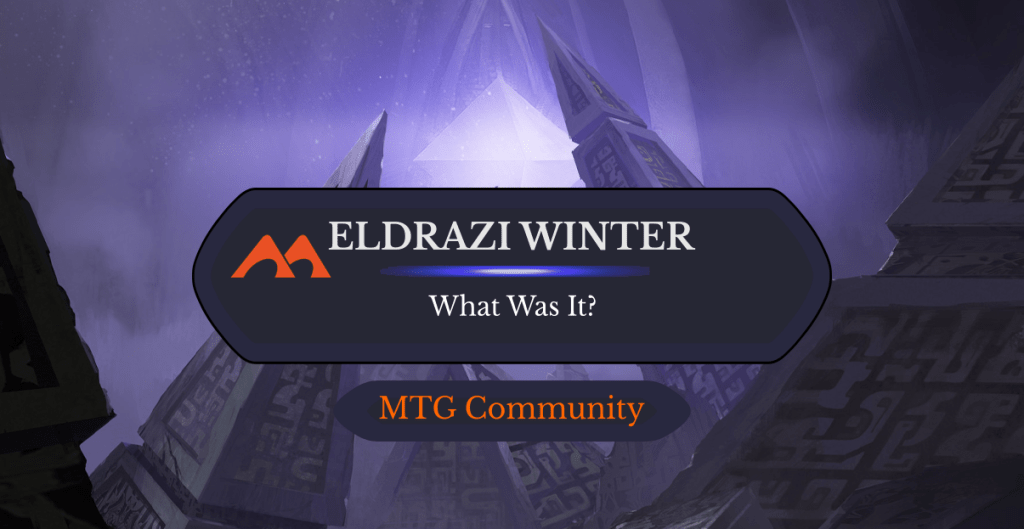
Eye of Ugin | Illustration by James Paick
For Modern MTG players and tournament grinders, Eldrazi Winter wasn’t a fond moment to remember, unless you were winning like hell with your Eldrazi deck. It’s never good when a tournament scene gets stale and there’s a best, unbeatable deck, right?
Today we’re answering the question: What was Eldrazi Winter? How did it happen and what were the main factors, or culprits, if you will?
Stay with me and we’ll get to the bottom of this story.
What Was Eldrazi Winter?
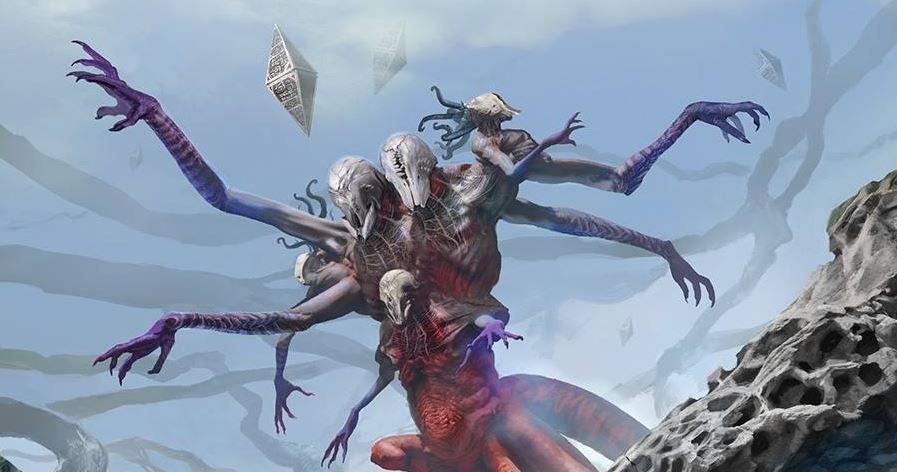
Endless One | Illustration by Jason Felix
Eldrazi Winter was a period of MTG competitive play utterly dominated by Eldrazi decks, mainly in the Modern format. The main culprits are a series of development mistakes involving various sets, notably Battle for Zendikar (BFZ) and Oath of the Gatewatch (OGW), as well as a metagame shift in Modern after the banning of cards like Splinter Twin and Summer Bloom.
Eldrazi Origins
Eldrazi were introduced to MTG in Rise of the Eldrazi, released in 2010. They’re very large, expensive, and powerful creatures, and most of them cost between 10-15 mana. Granted, they’re worth their mana value but are too expensive to see regular Constructed play; EDH wasn’t a popular thing back then.
WotC introduced ways to make the most out of your Eldrazi via two lands: Eye of Ugin and Eldrazi Temple. Both in play together generate 4 mana for you to cast your giant creatures, and that’s hardly breaking the game when you’re reducing the cost from 12 to 8. And god forbid someone has multiple Eldrazi Temples in play.
Eldrazi Ascension
Fast forward to 2015 and we’re returning to Zendikar, the plane that introduced the Eldrazi. Following the events of Rise of the Eldrazi, the Eldrazi, well… rose, and caused all sorts of mayhem on the plane.
Battle for Zendikar (BFZ) was released, and it introduced Eldrazi offspring, that is, cheaper and smaller Eldrazi. As one of the main creature types in BFZ, suddenly we’ve got cheaper but still strong Eldrazi creatures, like Blight Herder, Wasteland Strangler, and Drowner of Hope, with lower mana values.
Although they were safe in Standard, people started to realize that in Eternal formats like Modern, casting these early with Eye of Ugin and Eldrazi Temple was the way to go. Decks like Black Eldrazi Processors ascended into Modern Tier 1-1.5.
Eldrazi Dominance and the Eldrazi Winter
Following Battle For Zendikar, Oath of the Gatewatch was released. This set was probably designed with Standard in mind, intending to give Eldrazi decks a lower curve and more powerful early plays. The most impactful cards released in this set were Eldrazi Mimic, Matter Reshaper, Thought-Knot Seer, and Reality Smasher. These can be cast on a curve, with mana values 2 through 5. But what happens when these cards cost 2 less, or worse, 4 less?
The result is that we have a dominant deck that puts aggro decks like Zoo to shame, overpowers midrange/fair decks, is too fast and consistent for control, and is faster than combo decks. When you’re paying 2 mana to cast a 4/4 with disruption or 3 mana to cast a 5/5 with haste that has “ward – discard a card”, suddenly you’re doing the most powerful stuff possible. In the winter of 2016, called Eldrazi Winter, these decks proceeded to dominate every single Modern tournament, forcing WotC to take swift action and ban cards, effectively ending Eldrazi Winter.
Why Is It Called Eldrazi Winter?
After the release of BFZ and OGW, in the winter of 2016, Eldrazi was the dominant deck for weeks to come, mainly in Modern, but also making a splash in Legacy and Standard. The name is also a reference to previous periods in MTG history, called Combo Winter in Urza’s Saga and Combo Winter 2 with Mirrodin Affinity.
When Was the Eldrazi Winter?
Around February, 2016. Oath of the Gatewatch was released in January 2016, so the Eldrazi Winter is the period of time when the tournaments took place, mainly those organized by Star City Games, including Grand Prix, Pro Tour Qualifiers, and Pro Tour Oath of the Gatewatch itself. The Eldrazi Winter would end on April 4, 2016 after the banning of the card Eye of Ugin.
What Sets Were Released During the Eldrazi Winter?
The sets Battle for Zendikar (BFZ) and Oath of the Gatewatch (OGW) are the main culprits for the Eldrazi Winter, especially Oath of the Gatewatch.
Famous Eldrazi Winter Cards

Eye of Ugin makes all your Eldrazi spells 2 mana cheaper, so you can cast two Eldrazi Mimic for free or cast a Thought-Knot Seer on turn 2 with the help of Eldrazi Temple. It’s not hard for Eye of Ugin to generate 8-10 mana over the course of the game, and it has the Eldrazi tutor ability on top of it.
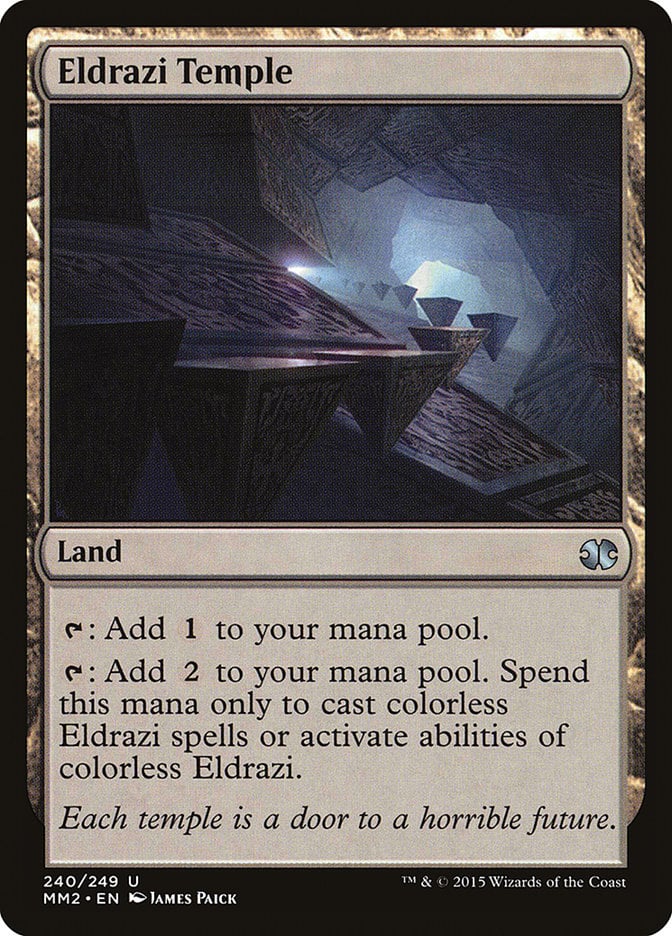
Eldrazi Temple generates 2 mana to cast your Eldrazi spells.
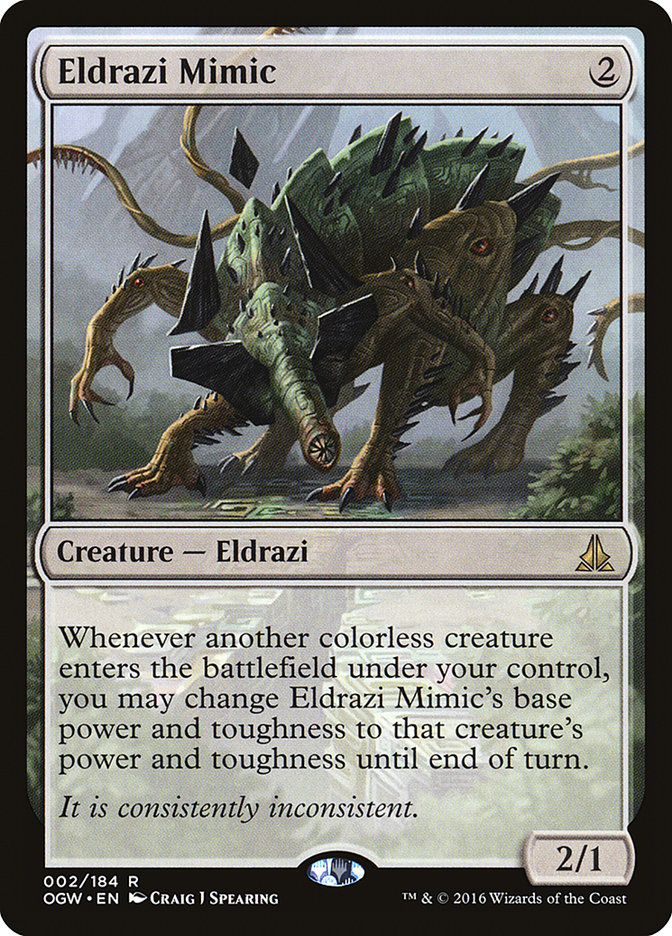
Eldrazi Mimic is a 2-drop that can be cast for free via Eye of Ugin or with a single Eldrazi Temple activation. It’ll also become stronger as you keep casting good Eldrazi, so your 2/1 can attack as 4/4 or stronger in the late game.

Thought-Knot Seer is a 4/4 that exiles a card from your opponent’s hand when it ETBs, giving them another card when it leaves the battlefield. This is already strong at 4 mana, and atrocious at 2. It’s card disadvantage for your opponent while it’s on the battlefield, and it gets way worse in multiples. If dealing with cards like Brain Maggot and Tidehollow Sculler is hard, wait until they're 4/4’s.
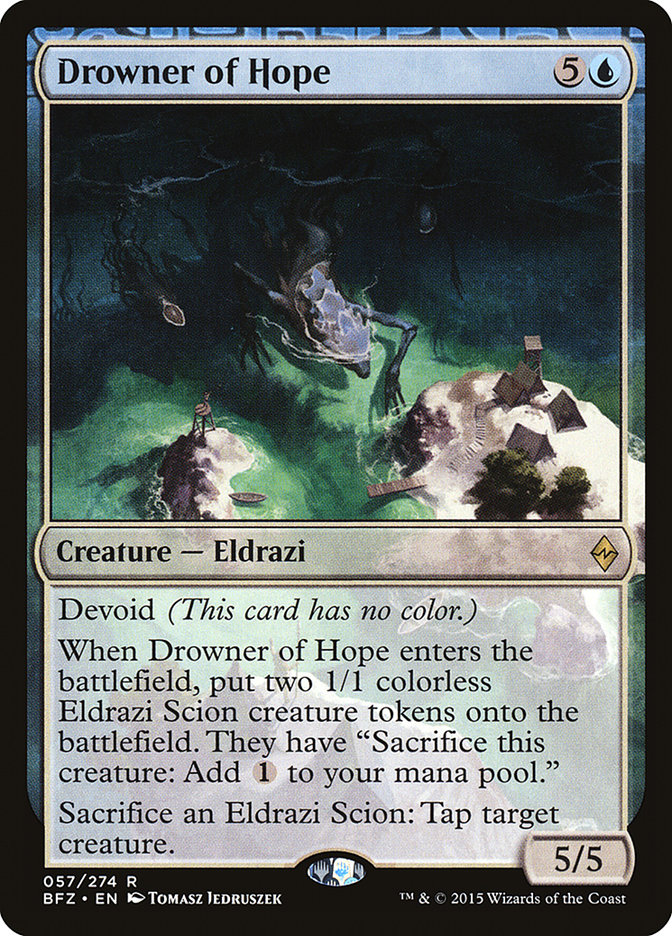
Besides being three bodies in one card, Drowner of Hope can be a stalemate breaker by sacrificing the tokens to tap enemy creatures and hit for the win.
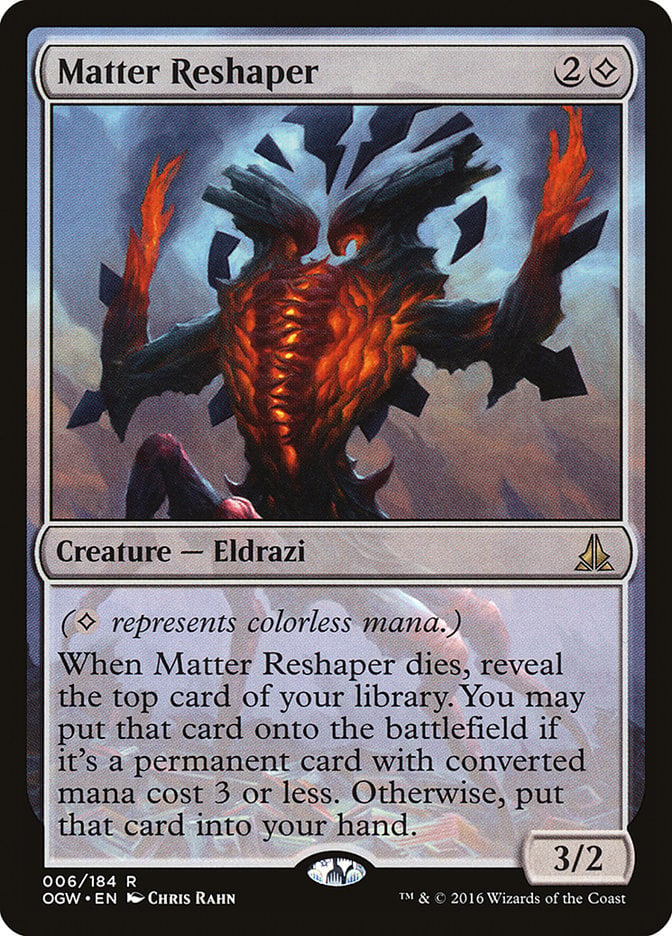
Matter Reshaper is a nice speed bump, a 3/2 that blocks, often trades, and gives you an extra card when it dies.

Reality Smasher is a nice finisher in Eldrazi decks, packing a punch with trample and haste and being resistant to spot removal.
Other honorable mentions include cards like Endless One, World Breaker, Eldrazi Displacer, Vile Aggregate, Ruination Guide, Oblivion Sower, and Endbringer.
Popular Eldrazi Winter Decks
Let’s take a look at some of the decks played during the Eldrazi Winter era:
Modern Blue-Red Eldrazi
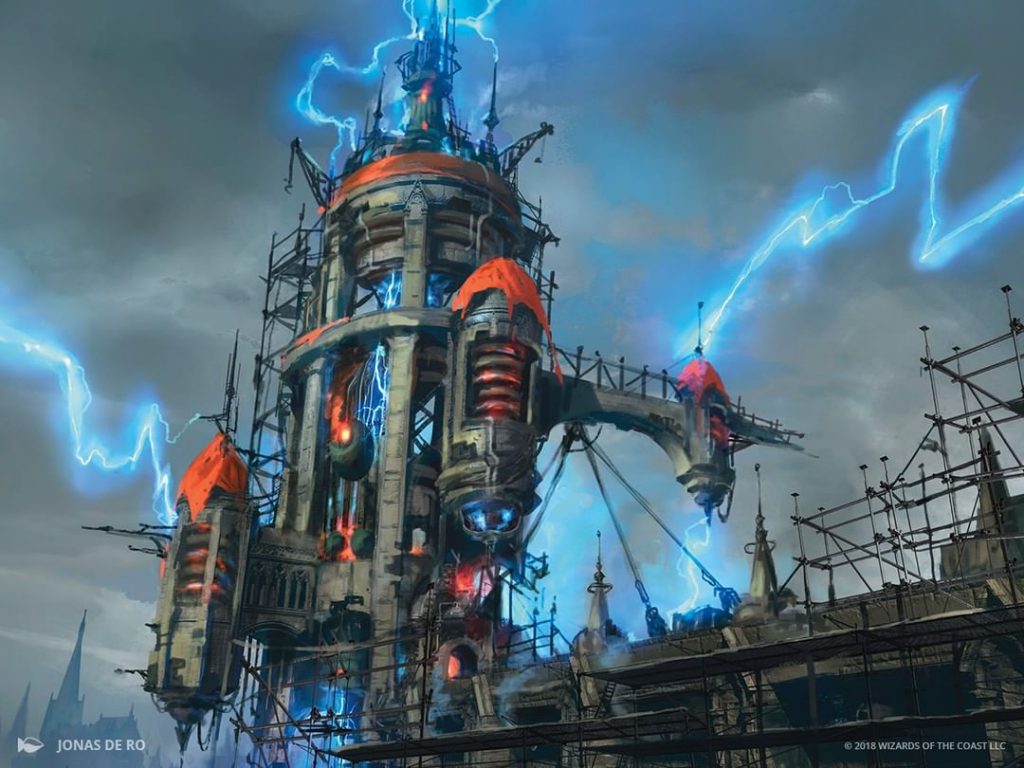
Steam Vents | Illustration by Jonas De Ro
Creature (33)
Drowner of Hope x4
Eldrazi Mimic x4
Eldrazi Obligator x3
Eldrazi Skyspawner x4
Endless One x4
Reality Smasher x4
Ruination Guide x2
Thought-Knot Seer x4
Vile Aggregate x4
Instant (3)
Dismember x3
Land (24)
Cavern of Souls x3
Eldrazi Temple x4
Eye of Ugin x4
Gemstone Caverns
Island x2
Scalding Tarn x4
Shivan Reef x4
Steam Vents x2
Sideboard (15)
Chalice of the Void x2
Gut Shot x2
Hurkyl's Recall x3
Ratchet Bomb
Relic of Progenitus x2
Spellskite
Stubborn Denial x3
Tomb of the Spirit Dragon
Jiachen Tao won the PT Oath of the Gatewatch with this Eldrazi deck. Tao’s list is totally focused on red and blue Eldrazi, exploiting the go-wide synergies between Eldrazi Skyspawner and Drowner of Hope that generate tokens, Ruination Guide that buffs them, and Vile Aggregate that just gets massive.
Modern Colorless Eldrazi
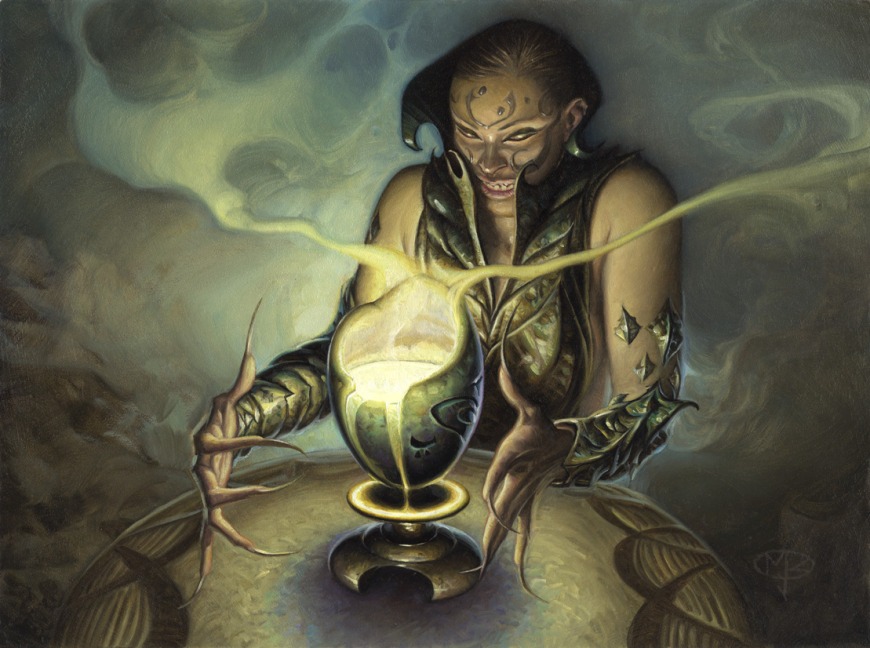
Chalice of the Void | Illustration by Mark Zug
Creature (26)
Eldrazi Mimic x4
Endless One x4
Matter Reshaper x4
Reality Smasher x4
Simian Spirit Guide x4
Spellskite x2
Thought-Knot Seer x4
Instant (4)
Dismember x4
Artifact (6)
Chalice of the Void x4
Ratchet Bomb x2
Land (24)
Blinkmoth Nexus x4
Eldrazi Temple x4
Eye of Ugin x4
Ghost Quarter x4
Mutavault x3
Urborg, Tomb of Yawgmoth x3
Wastes x2
Sideboard (15)
Gut Shot x3
Oblivion Sower x3
Pithing Needle x2
Ratchet Bomb
Relic of Progenitus x4
Spellskite
Warping Wail
MTG Hall of Famer Luis-Scott Vargas made PT Oath of the Gatewatch top 8 with this Colorless Eldrazi deck. We can see that he was worried about the rest of the field by playing disruption like Spellskite and Chalice of the Void. After all, Modern should be in theory a very diverse field.
Abzan Company

Anafenza, Kin-Tree Spirit | Illustration by Ryan Yee
Creature (29)
Anafenza, Kin-Tree Spirit x2
Birds of Paradise x4
Eternal Witness x3
Fiend Hunter
Viscera Seer x2
Voice of Resurgence x2
Wall of Roots x2
Melira, Sylvok Outcast x2
Murderous Redcap
Noble Hierarch x3
Orzhov Pontiff
Kitchen Finks x4
Spellskite x2
Instant (8)
Chord of Calling x4
Collected Company x4
Land (23)
Forest x2
Gavony Township x2
Godless Shrine
Horizon Canopy x2
Overgrown Tomb x2
Plains
Razorverge Thicket x2
Swamp
Temple Garden x2
Verdant Catacombs x4
Windswept Heath x4
Sideboard (15)
Abrupt Decay x2
Intrepid Hero
Kataki, War's Wage
Linvala, Keeper of Silence
Path to Exile x3
Phyrexian Revoker
Qasali Pridemage
Reveillark
Scavenging Ooze
Sin Collector
Thoughtseize x2
In the hands of Ralph Betesh, this deck beat the Eldrazi all the way in a Modern Grand Prix. This deck focuses on gaining infinite life to stop the beatdowns and has interesting sideboard choices like Intrepid Hero to destroy the big Eldrazi and cheap removal in Path to Exile.
Major Tournaments During the Eldrazi Winter
Pro Tour Oath of the Gatewatch – 02/05/2016
PT Oath of the Gatewatch was a Modern Pro Tour, following the release of Oath of the Gatewatch. The most interesting thing about this PT is that Eldrazi was 8% of the Day 1 metagame and proceeded to dominate the PT Top 8. At the time the Eldrazi deck was known but heavily underestimated by the pros, considered a lower-tier deck. This table shows the PT Day 1 metagame breakdown:
| Deck | Day 1 Metagame % |
| Affinity | 13 |
| Burn | 13 |
| Infect | 8 |
| Eldrazi | 8 |
| Zoo | 6 |
| Abzan | 5 |
| Jund | 5 |
| Scapeshift | 3 |
| Other | 39 |
Other decks include all sorts of stuff Modern is known for, including Control, Kiki-Jiki combo, Storm, Ad Nauseam, Death and Taxes, Boggles, Elves, and the like.
The Eldrazi deck was an important but small part of the metagame, and following the bannings of Splinter Twin and Summer Bloom, the meta was more diverse than ever.
On PT Day 2, Eldrazi was already 10% of the meta, a small increase. In this Pro Tour, six players made the Top 8 playing Eldrazi decks (75%), including PT Winner Jiachen Tao. The other top 8 players were piloting affinity decks. After this PT, it was clear that the metagame would have to adapt: You’d either play Eldrazi or play to beat Eldrazi.
The following weekends saw 14 copies of Eldrazi decks among three Grand Prix – 50% of all GP Top 8's. Grand Prix Bologne, Detroit, and Melbourne were dominated by Eldrazi decks, even with the competitors tuning their decks to beat them. Two of these tournaments were decided in a mirror match between Eldrazi decks, and one of them, GP Detroit, saw Abzan Company beating an Azorius Eldrazi deck, the first Modern final that wasn’t an Eldrazi mirror.
How Did The Eldrazi Winter End?
After the Pro Tour, people started adapting to the Eldrazi menace, provoking some shifts in the metagame.
- Tron decks started playing more Eldrazi and less Karn Liberated.
- Control decks were relying more on Condemn, Path to Exile, and a miracled Terminus to keep up with the powerful threats.
- Prison decks became a possibility to try and beat these creature decks, with cards like Ensnaring Bridge that prevent you from being attacked. Since Eldrazi decks were low on removal spells, Worship became a nice sideboard card and sometimes even a main deck one.
- People started to play Eldrazi decks designed to beat other Eldrazi decks, like a Gruul variant focused on getting bigger creatures and playing sweepers like Kozilek's Return. Or a version playing Eldrazi Displacer that made some GP Top 8’s shortly after.
- Oblivion Sower gets more play as a way to steal lands from Eldrazi opponents and go over the top of them.
Eldrazi had their time to shine shortened, both competitively and story-wise. In the lore, the planeswalkers that formed the Gatewatch obliterated the Eldrazi titans Ulamog and Kozilek on Zendikar. Competitively, Eye of Ugin was identified as the card that gave the deck speed as well as consistency due to its repeated tutor ability and was banned from the Modern format. After that, the deck stopped being that dominant of a force and continued to be played in Modern tier 1-1.5 until the War of the Spark – Modern Horizons era.
Wrap Up
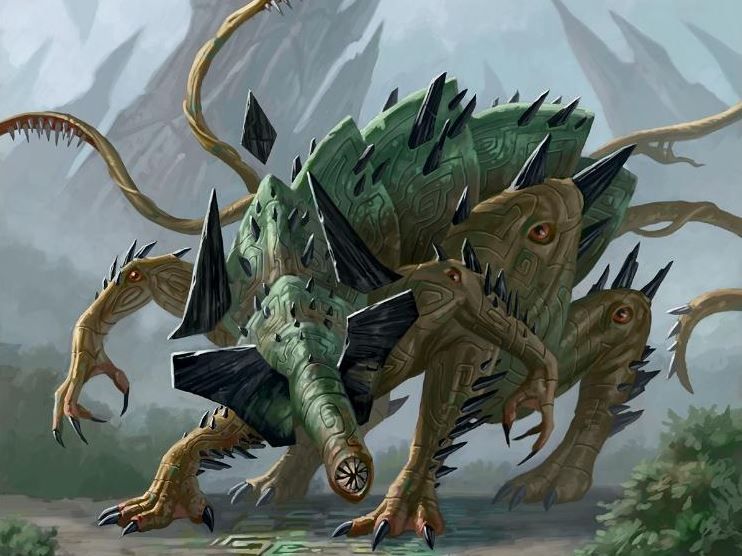
Eldrazi Mimic | Illustration by Craig J. Spearing
Sometimes, MTG development mistakes in cards happen and pro players capitalize on them. Eternal formats like Modern, Legacy, and Vintage suffer a lot from this because cards are developed for Standard, and it’s impossible to predict all the interactions between different cards across formats. Eldrazi Winter was an era utterly dominated by a single deck, something that wouldn’t be repeated until Hogaak summer era, which is a story for another day.
Were you playing competitively in that era? Do you think Modern’s current power level supports Eye of Ugin? Let me know your opinions in the comments below, or in our Discord Server.
Thanks for reading guys, and let’s all appreciate the banning of Eye of Ugin while it lasts.
Follow Draftsim for awesome articles and set updates: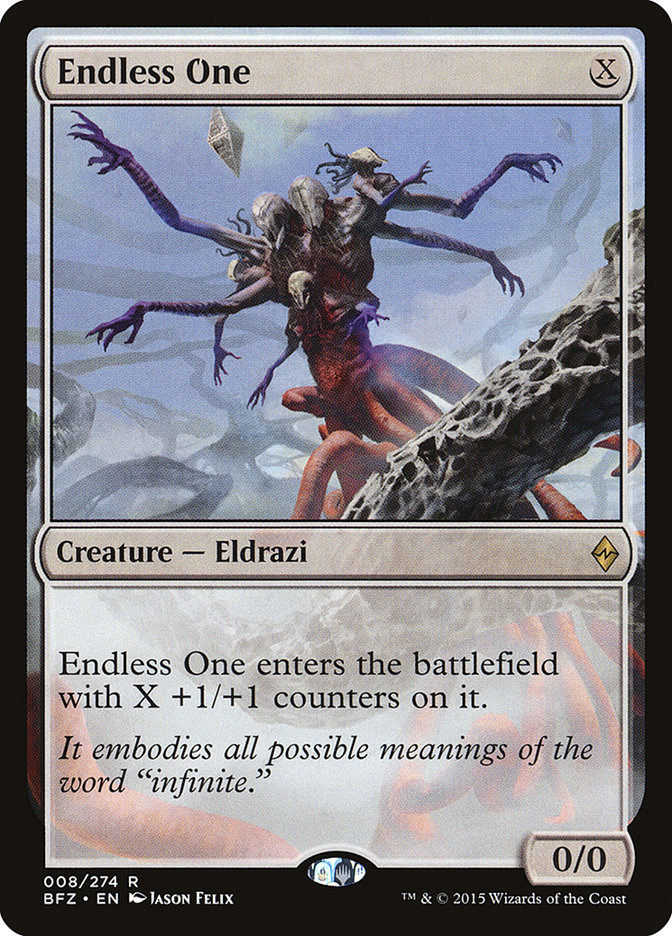

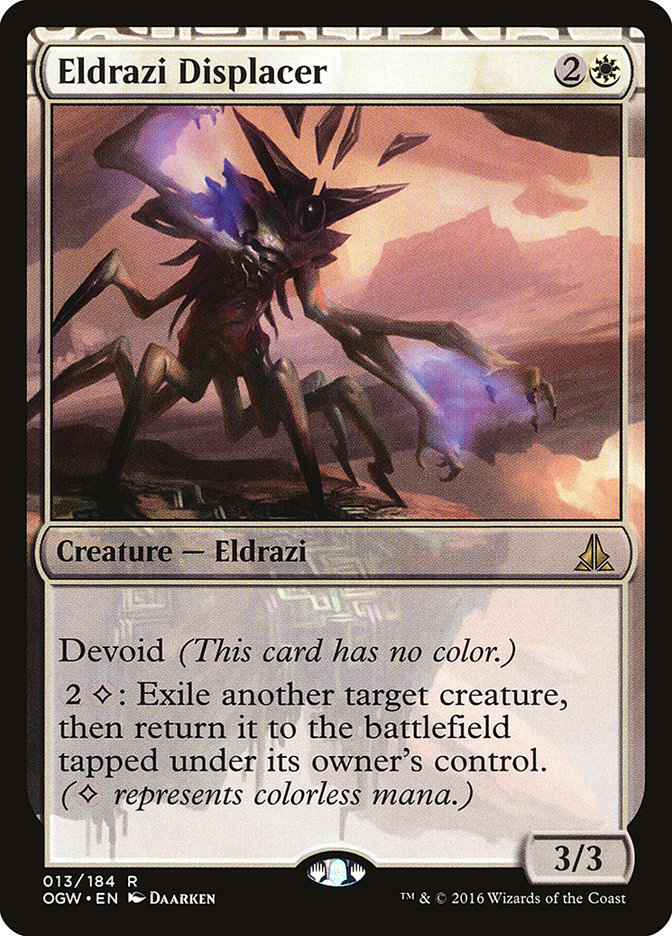
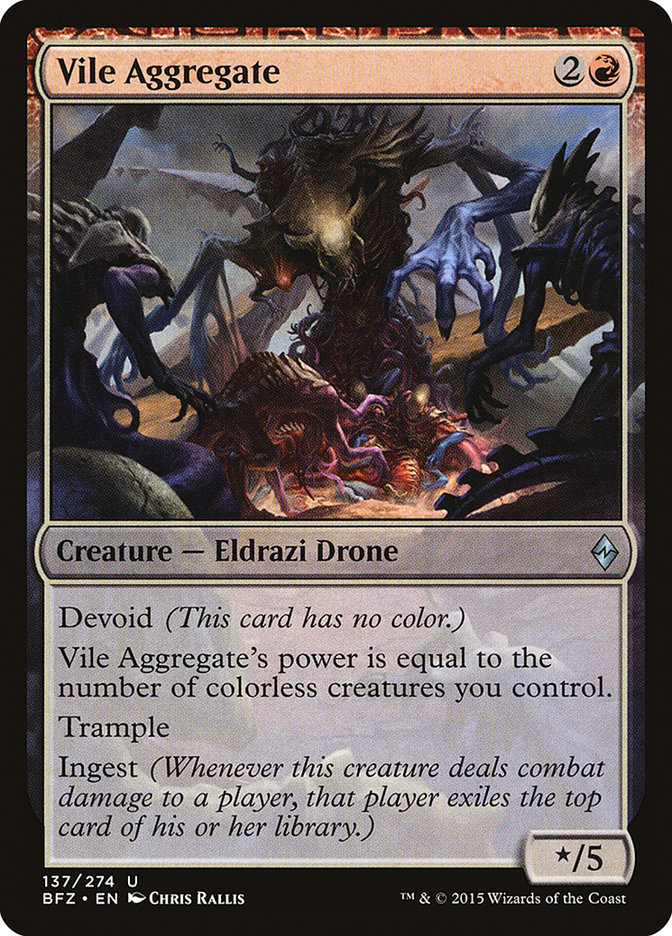
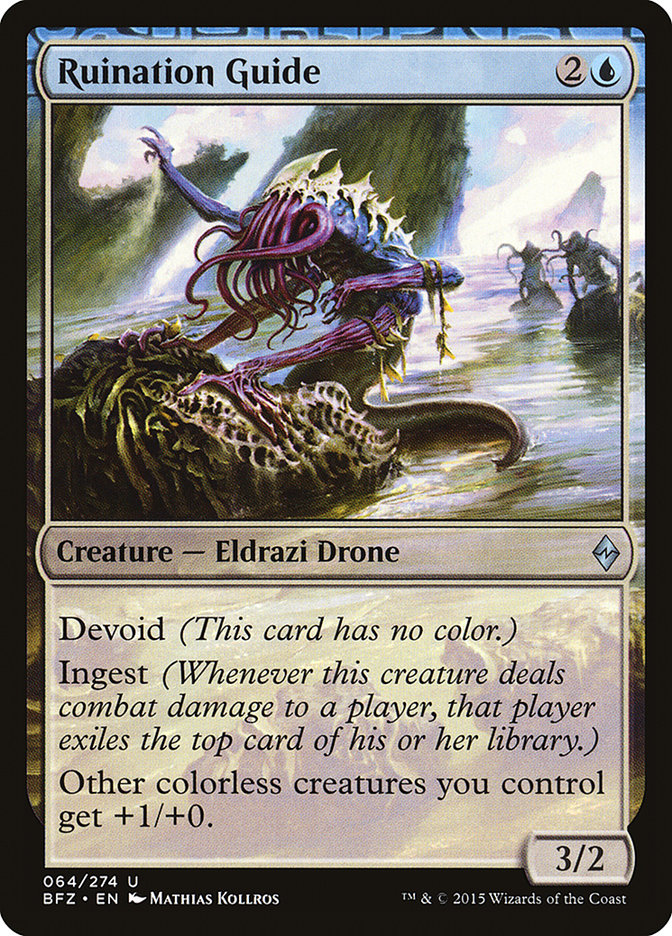
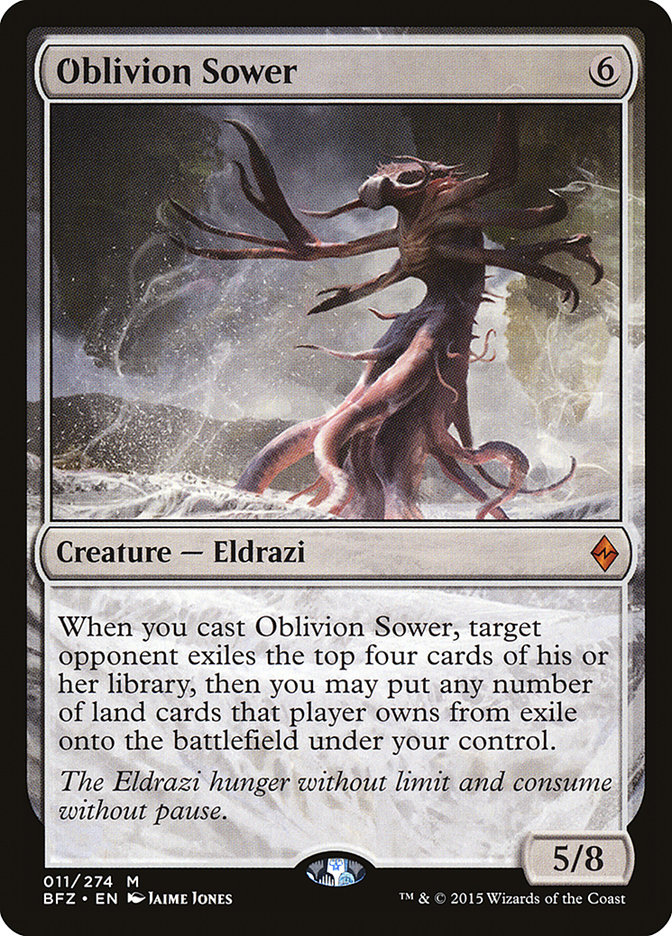
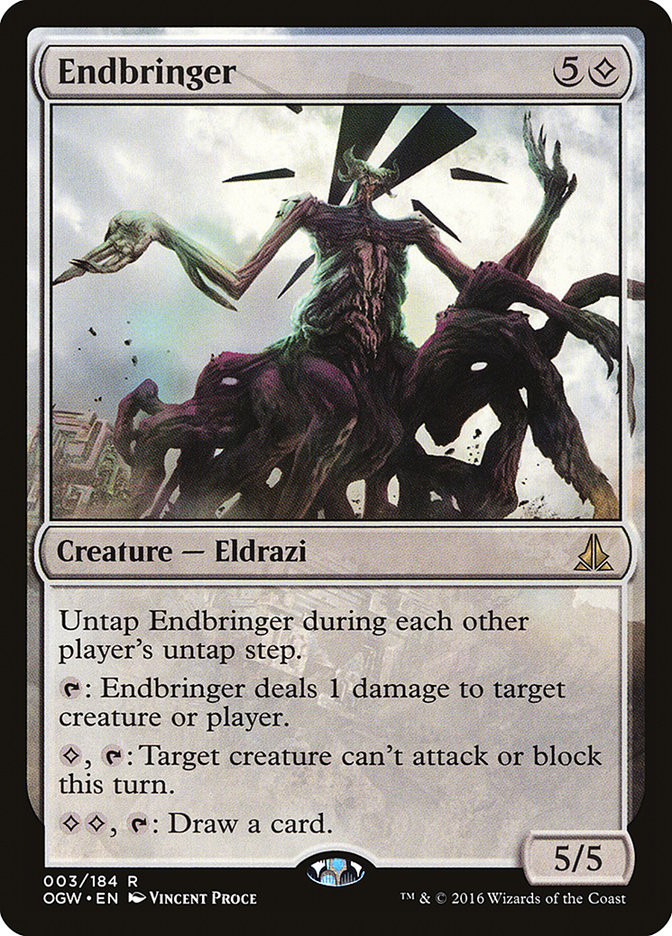
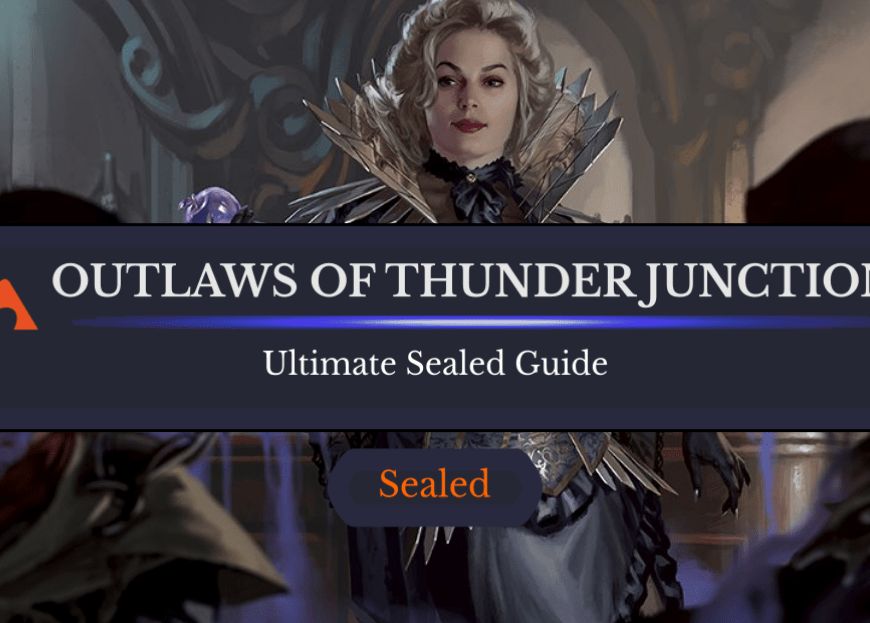

Add Comment